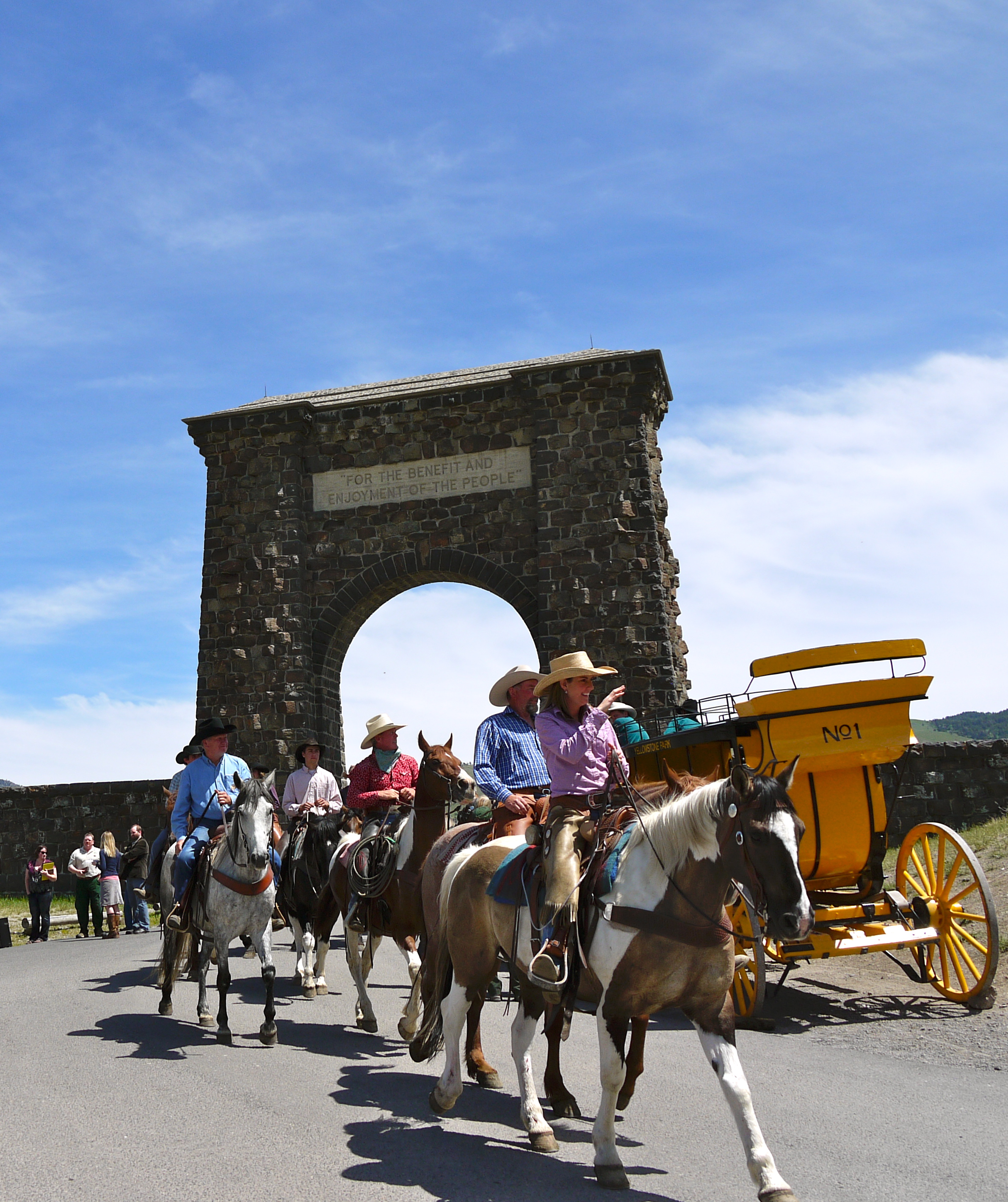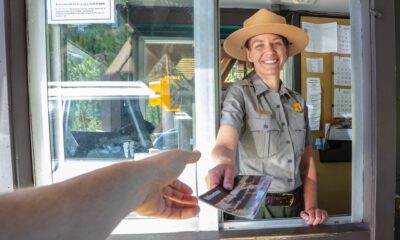Yellowstone
Featured Outlaw: Theodore Roosevelt
Published
10 years agoon
Posted By
Outlaw PartnersBy Tyler Allen Explore Big Sky Associate Editor
Spanning the north entrance to Yellowstone National Park in Gardiner, Montana, the
Roosevelt Arch is a monument to our country’s collective conscious, a symbol of the
progressive conservation values fervently championed by President Theodore
Roosevelt.
Standing beside the stone arch on April 24, 1903, after a two-week tour of the park,
Roosevelt spoke to this symbolism as he dedicated the unfinished monument that
would eventually bear his name.
“Nowhere else in any civilized country is there to be found such a tract of veritable
wonderland made accessible to all visitors,” the president told the crowd in
Gardiner.
Roosevelt had ridden his executive train, The Elysian, south through Paradise Valley
on April 8, to Cinnabar, north of Gardiner. The trip was intended as a respite during
an exhaustive eight-week domestic tour, and the president spent it hiking and
horseback riding, and observing large herds of elk, blacktail and whitetail deer and
pronghorn, as well as the last remaining bison in the Greater Yellowstone, captive at
Mammoth.
Camping on the Yellowstone River below Tower Falls, he marveled at the bighorn
sheep, and learned from a road crew camped nearby of the animals’ acuity
negotiating the steep, icy precipices.
“When we first saw them they were lying sunning themselves on the edge of the
canyon, where the rolling grassy country behind it broke off into the sheer decent,”
he later wrote. “Before dark they all lay down again on a steeply inclined jutting
spur midway between the top and bottom of the canyon.”
At the journey’s end, Roosevelt’s party rode north from Mammoth. A mile from
Gardiner, they crested a hill to see a throng gathered, awaiting his arrival.
__________
The strongest public lands advocate to ever occupy the White House, Theodore
Roosevelt accomplished his initiatives despite daunting opposition from big business
and land barons, who saw the West as an inexhaustible faucet of money and power.
The man who found respite homesteading and hunting the wilds of the Dakotas –
escaping public life after his mother and first wife died on the same day in 1884 –
and who led the Rough Riders into battle during the Spanish-American war, rarely
backed down from a challenge, either political or physical.
Elected governor of New York in 1898, Roosevelt installed a wrestling mat in the
executive mansion in Albany, sparring with official guests for sport. While serving as vice president under President William McKinley, Roosevelt was
elevated to the executive office on September 14, 1901, when McKinley succumbed
to an assassin’s bullet fired eight days earlier. The 42-year-old Roosevelt retained
McKinley’s cabinet and vowed publicly to change little; privately, however, he
articulated a new direction for the Republican Party, away from the special interests
he believed were exploiting the country’s impoverished and its natural resources.
In the late 19th century, logging was nearly unrestricted in the West, and mining
claims were staked unencumbered by federal oversight. President Grover Cleveland
set aside 21 million acres of forest reserves before leaving office in 1897, but
McKinley suspended the order after entering the White House. Roosevelt and his
Forest Service Chief Gifford Pinchot began zealously conserving western forests
after the president’s landslide reelection in 1904 and the creation of the Forest
Service in 1905.
In 1907, Idaho Senator and land baron Weldon B. Heyburn pushed an amendment to
a spending bill through Congress that stripped a president’s authority to create new
National Forests without congressional approval.
The bill had to be signed to keep the government running – considered essential at
the time – but Roosevelt had a week. So, he and Pinchot spread maps of the West
across the White House floor, and added 16 million acres of National Forest land by
executive proclamation. Roosevelt then signed the bill, preventing any president
from doing such a thing again.
Livid, Heyburn and his allies were left without recourse. The National Forest system
now totaled almost 180 million acres.
__________


A procession passes beneath the Roosevelt Arch in June 2012, after a ceremonial agreement to improve infrastructure around the park’s entrance. The arch Roosevelt dedicated in 1903 today represents the 26th president’s determination to conserve public land. PHOTO BY EMILY STIFLER WOLFE
April 24, 1903, was a warm spring day in Gardiner. Storefronts were decorated with
American flags and red, white and blue bunting. Trainloads arrived from Livingston,
and the crowd was an estimated 3,700 by the time the president arrived, just after
4 p.m.
Before his speech, a group of Masons from the Grand Lodge of Montana placed a
box of memorabilia including copies of four regional daily newspapers, a 1903
World’s Almanac and the Bible in a cavity inside one of the stones. Roosevelt spread
mortar atop it with a trowel, and then the cornerstone, etched with the date, was
lowered into place using a block and tackle.
Roosevelt spoke that day about the “essential democracy” of national parks.
“Here all the wild creatures of the old days are being preserved, and their overflow
into the surrounding country means that the people…will be able to insure to
themselves and to their children and their children’s children much of the old time
pleasures of the hardy life of the wilderness.”Then, Roosevelt rode north to Cinnabar, leaving on The Elysian at 6 p.m. He never
visited the park again or saw the completed arch that represents the heritage of his
ideals.
As long as the Roosevelt Arch stands, it will represent the 26th president’s
determination to conserve the country’s resources for future generations, and his
rejection of those who use our collective treasures for profit.
This story was first published in the winter 2013/2014 issue of Mountain Outlaw magazine.
The Outlaw Partners is a creative marketing, media and events company based in Big Sky, Montana.


Upcoming Events
april, 2024
Event Type :
All
All
Arts
Education
Music
Other
Sports
Event Details
Children turning 5 on or before 9/10/2024:
more
Event Details
Children turning 5 on or before
9/10/2024: Kindergarten
enrollment for the 2024-2025 school year can be completed by following the
registration process now.
Children
born on or after September 11, 2019: 4K enrollment is now open for
families that have a 4-year-old they would like to enroll in our program for
the 2023-2024 school year. Please complete the 4K Interest Form to
express your interest. Completing this form does not guarantee enrollment into
the 4K program. Enrollment is capped at twenty 4-year-olds currently
residing within Big Sky School District boundary full time and will be
determined by birth date in calendar order of those born on or after September
11, 2018. Interest form closes on May 30th.
Enrollment now is critical for fall preparations. Thank you!
Time
February 26 (Monday) - April 21 (Sunday)
Event Details
Saturday, March 23rd 6:00-8:00pm We will combine the heart-opening powers of cacao with the transcendental powers of breathwork and sound. Together, these practices will give us the opportunity for a deep
more
Event Details
Saturday, March 23rd 6:00-8:00pm
Time
March 23 (Saturday) 6:00 pm - April 23 (Tuesday) 8:00 pm
Location
Santosha Wellness Center
169 Snowy Mountain Circle
Event Details
We all are familiar with using a limited palette, but do you use one? Do you know how to use a
more
Event Details
We all are familiar with using a limited palette, but do you use one? Do you know how to use a limited palette to create different color combinations? Are you tired of carrying around 15-20 different tubes when you paint plein air? Have you ever wanted to create a certain “mood” in a painting but failed? Do you create a lot of mud? Do you struggle to achieve color harmony? All these problems are addressed in John’s workbook in clear and concise language!
Based on the bestselling “Limited Palatte, Unlimited Color” workbook written by John Pototschnik, the workshop is run by Maggie Shane and Annie McCoy, accomplished landscape (acrylic) and plein air (oil) artists,exhibitors at the Big Sky Artists’ Studio & Gallery and members of the Big Sky Artists Collective.
Each student will receive a copy of “Limited Palette, Unlimited Color” to keep and take home to continue your limited palette journey. We will show you how to use the color wheel and mix your own clean mixtures to successfully create a mood for your paintings.
Each day, we will create a different limited palette color chart and paint a version of a simple landscape using John’s directives. You will then be able to go home and paint more schemes using the book for guidance.
Workshop is open to painters (oil or acrylic) of any level although students must have some basic knowledge of the medium he or she uses. Students will be provided the book ($92 value), color wheel, value scale and canvas papers to complete the daily exercises.
Sundays, April 14, 21 and 28, 2024
Noon until 6PM.
$170.
Time
14 (Sunday) 12:00 pm - 28 (Sunday) 6:00 pm
Event Details
Come join us at Cowboy Coffee as we celebrate a fun night of drinks, games, and meeting others within the community. This event is from 6-8 and all are welcome
Event Details
Come join us at Cowboy Coffee as we celebrate a fun night of drinks, games, and meeting others within the community. This event is from 6-8 and all are welcome to come, if you don’t know who to bring come alone this is a great mixer event! This is an event hosted by Big Sky OUT as we work to provide queer safe spaces throughout the community.
Time
(Sunday) 6:00 pm - 8:00 pm
Location
Cowboy Coffee
25 Town Center Ave. Big Sky, MT 59716










